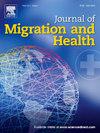探讨挪威移民遵守COVID-19感染控制措施和建议的障碍:一项定性研究。
IF 2.9
Q1 PUBLIC, ENVIRONMENTAL & OCCUPATIONAL HEALTH
引用次数: 0
摘要
背景:自2019冠状病毒病大流行开始以来,世界各地不同当局发布了各种感染控制措施和建议,以防止感染的传播和相关死亡率。然而,对建议的支持和遵循的能力因国家和人群而异。在挪威,研究表明,与普通人群相比,移民在COVID-19感染、住院和相关死亡率方面的负担更高。因此,有必要调查不同背景的人如何理解和采取行动应对COVID-19措施和建议。目的:本定性研究探讨了移民在遵守COVID-19措施和建议的态度和障碍方面的经验和看法。方法:对来自9个不同国家背景的移民进行深度访谈。数据采用专题分析进行分析。结果:分析反映了三个不同层面的障碍:个人、文化和系统。在个人层面上,语言障碍、信息障碍和物质障碍构成了分主题。在文化层面,出现了与集体主义文化实践有关的期望。在系统层面上,明显存在翻译不良、传播滞后、信息超载、修改频繁等问题。结论:本研究加深了对移民如何以及哪些因素认为是遵守COVID-19措施和建议的障碍的理解。了解移民的观点对于未来制定政策和改善不同群体之间的信息传播至关重要。本文章由计算机程序翻译,如有差异,请以英文原文为准。

Exploring barriers to adherence to COVID-19 infection control measures and advice among immigrants in Norway: A qualitative study
Background
Since the beginning of the COVID-19 pandemic, various infection control measures and advice have been issued by different authorities across the world to prevent the spread of the infection and associated mortality. However, the support for and ability to follow recommendations varies across countries and populations. In Norway, studies have shown that immigrants bear a higher burden of COVID-19 infections, hospitalizations, and associated mortality compared with the general population. This warrants investigation into how people from different backgrounds understand and act in response to COVID-19 measures and advice.
Aim
This qualitative study explored the experiences and perceptions of immigrants in respect of attitudes and barriers to adherence to COVID-19 measures and advice.
Methods
In-depth interviews were conducted with immigrants from nine different country backgrounds. Data was analyzed using thematic analysis.
Results
The analyses reflected barriers at three different levels: individual, cultural, and systemic. At the individual level, language, information barriers and material barriers formed sub-themes. At the cultural level, expectations relating to collectivistic cultural practice emerged. At the systemic level, poor translation and late dissemination, and overload and frequent modification of information were evident.
Conclusion
This study provides enhanced understanding of how and what immigrants perceive as barriers to adherence to COVID-19 measures and advice. Understanding immigrants’ perspectives is crucial to tailoring policies and improving information dissemination among different groups in the future.
求助全文
通过发布文献求助,成功后即可免费获取论文全文。
去求助
来源期刊

Journal of Migration and Health
Social Sciences-Sociology and Political Science
CiteScore
5.70
自引率
8.70%
发文量
65
审稿时长
153 days
 求助内容:
求助内容: 应助结果提醒方式:
应助结果提醒方式:


